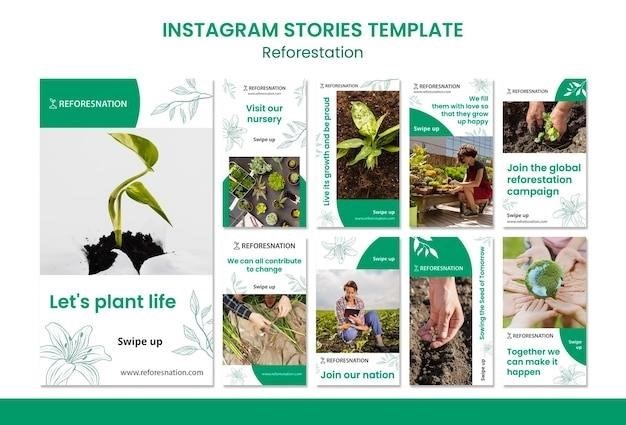This comprehensive guide provides practical tips and techniques for cultivating a thriving garden, focusing on fostering robust root systems for optimal plant growth․ From companion planting to soil preparation, learn how to nurture your plants from the ground up and ensure they flourish with vibrant health and abundant yields․
Companion Planting
Companion planting is a gardening technique that involves strategically placing different plant species together to enhance growth, deter pests, and attract beneficial insects․ This practice capitalizes on the synergistic relationships between plants, creating a harmonious and thriving ecosystem within your garden․ By understanding the benefits of companion planting, you can maximize your garden’s productivity and minimize the need for chemical interventions․
For instance, planting herbs like basil, rosemary, and thyme alongside tomatoes can repel common pests like aphids and whiteflies․ These aromatic herbs release volatile compounds that confuse and deter these insects, protecting your tomatoes․ Similarly, planting marigolds near vegetables like beans, squash, and cucumbers can discourage nematodes, microscopic roundworms that can damage roots․ Marigolds release a natural compound that repels nematodes, keeping your vegetables healthy and thriving․
Furthermore, companion planting can improve soil health and nutrient availability․ Deep-rooted crops like melons and tomatoes pull water and nutrients from deeper in the soil profile, making these resources accessible to shallower-rooted plants․ Adding legumes like peas, beans, and clover to your garden can enhance soil fertility by fixing nitrogen from the atmosphere into the soil, providing a readily available source of this essential nutrient for other plants․
By implementing companion planting strategies, you can create a balanced and resilient garden ecosystem․ The benefits extend beyond pest control and nutrient enhancement; companion planting can also improve pollination, attract beneficial insects, and enhance the overall beauty and biodiversity of your garden․
Bare-Root Plants
Bare-root plants offer a budget-friendly and eco-conscious alternative to container-grown plants․ These plants, typically dormant during the planting season, have their roots exposed, making them lightweight and easy to transport․ While they may appear less robust initially, bare-root plants possess several advantages that make them a compelling choice for gardeners․
One of the primary benefits of bare-root plants is their affordability․ Since they lack the added weight and volume of soil found in containers, they are generally sold at lower prices than container-grown plants․ This makes them an attractive option for budget-conscious gardeners who want to establish a large-scale garden without breaking the bank․
Furthermore, bare-root plants often establish more quickly than container-grown plants․ This is because their roots are not confined to a pot and can immediately spread out and explore the soil․ As a result, they tend to develop a more extensive root system, leading to faster growth and greater resilience․
In addition to their affordability and rapid establishment, bare-root plants are also known for their low-maintenance nature․ Since they are not confined to a pot, their roots are less susceptible to root-bound issues, which can lead to stunted growth and poor health․
Overall, bare-root plants offer a practical and economical choice for gardeners seeking to establish a thriving garden․ Their affordability, rapid establishment, and low-maintenance nature make them a valuable option for both experienced and novice gardeners alike․
Propagation
Propagation is a fascinating and rewarding aspect of gardening that allows you to expand your plant collection and share your favorite specimens with others․ It involves the art of creating new plants from existing ones, utilizing various methods that capitalize on the plant’s natural ability to reproduce․
One of the most common propagation methods is taking cuttings․ This involves snipping a section of stem, leaf, or root from a healthy parent plant and encouraging it to develop roots․ Cuttings can be taken from various plants, including herbs, shrubs, and even some trees․
Another method is layering, where a stem or branch is bent and buried in the soil, encouraging it to produce roots․ This technique is particularly effective for plants that readily root from stems, such as raspberries and roses․
Division involves separating a mature plant into multiple individual plants․ This method is ideal for clump-forming perennials that tend to overcrowd their space․ By dividing the clump, you can rejuvenate the parent plant and create new plants to fill your garden․
Finally, seed propagation offers a simple and affordable way to grow new plants from seeds․ This method requires patience, as seed germination can vary depending on the plant species and environmental conditions․ However, it allows you to enjoy the joy of watching a tiny seed transform into a vibrant plant․
Propagation not only allows you to expand your garden but also offers a sense of accomplishment and connection to the natural world․ By mastering these techniques, you can create a thriving garden filled with plants you have nurtured from the very beginning․
Division
Division is a simple and effective propagation method for multiplying your favorite perennials․ It involves separating a mature plant into multiple individual plants, each with its own root system․ This technique is ideal for clump-forming perennials that tend to overcrowd their space and benefit from occasional rejuvenation․
The best time to divide perennials is in early spring or late summer, depending on the plant species․ Choose a cool, cloudy day to minimize stress on the plants․ Start by digging around the plant, carefully lifting it from the ground․ If the plant is large and dense, you may need to use a sharp spade or garden fork to divide it․
Once the plant is out of the ground, use a sharp knife or spade to cut the clump into sections, ensuring that each section has a healthy root system and a few healthy stems․ If the plant has become woody or congested, you can also remove the oldest, most crowded stems to promote new growth․
Prepare individual planting holes for each section, ensuring that they are wide and deep enough to accommodate the root system․ Plant the sections at the same depth as they were originally growing, and water them thoroughly․ With proper care, your divided perennials will quickly establish themselves and flourish in their new locations․
Division not only allows you to multiply your plants but also helps to rejuvenate them, ensuring that they continue to thrive for years to come․ It’s a simple and rewarding technique that is sure to benefit your garden․
Soil Preparation
The foundation of a thriving garden lies in well-prepared soil․ It’s the medium that nourishes your plants, providing essential nutrients, moisture, and aeration for healthy root growth․ Proper soil preparation sets the stage for vibrant blooms and bountiful harvests․
Begin by analyzing your soil’s existing condition․ A simple soil test will reveal its pH level, nutrient content, and texture․ This information guides your amendments, ensuring you provide the ideal growing environment for your chosen plants․ For example, if your soil is acidic, adding lime will raise the pH level to a more suitable range․ If it lacks nutrients, incorporating compost or well-rotted manure will enrich its fertility․
Next, work the soil to improve its structure and drainage․ Use a garden fork or tiller to loosen compacted soil, allowing air and water to penetrate more easily․ Incorporate organic matter, such as compost or shredded leaves, to enhance the soil’s texture, improve drainage, and provide nutrients․
Before planting, gently rake the soil to create a smooth surface for seed sowing or planting․ This ensures consistent depth for seedlings and promotes even moisture distribution․ By taking the time to prepare your soil meticulously, you provide your plants with a nurturing foundation that supports their growth and maximizes their potential․
Remember, well-prepared soil is the key to a flourishing garden, so invest the time and effort to create a healthy growing environment for your plants․

Watering
Providing your garden with the right amount of water is crucial for healthy plant growth․ Overwatering can lead to root rot, while underwatering can stunt growth and leave plants vulnerable to stress․ The key is to strike a balance that keeps the soil consistently moist, but not soggy․
The frequency and depth of watering depend on several factors, including soil type, climate, plant variety, and the stage of growth․ Clay soils retain moisture longer than sandy soils, while hot, dry climates require more frequent watering․ Young seedlings need more frequent watering than established plants․
A good rule of thumb is to water deeply but less often․ This encourages roots to grow deep into the soil, seeking moisture, and making the plant more resilient to drought conditions․ Water until the soil is thoroughly saturated, allowing excess water to drain away․ Check the moisture level by inserting your finger into the soil; if it feels dry, it’s time to water․
Use a watering can or hose with a gentle spray to avoid disturbing delicate seedlings or eroding the soil․ Watering in the morning allows the soil to dry slightly during the day, reducing the risk of fungal diseases․ Avoid watering during the hottest part of the day, as evaporation can be high․
By understanding the needs of your plants and adapting your watering practices accordingly, you can ensure your garden receives the hydration it needs to thrive․
Fertilizing
Fertilizing your garden provides essential nutrients that plants need to grow strong and healthy․ It replenishes the soil’s natural resources, promoting robust root development, vibrant foliage, and abundant blooms․ The type and amount of fertilizer needed vary depending on the plant species, soil type, and growth stage․
Organic fertilizers, such as compost, manure, and bone meal, are excellent sources of nutrients and improve soil structure․ They release nutrients gradually, providing a steady supply over time․ Synthetic fertilizers offer a quicker, more concentrated source of nutrients, but they can also deplete soil health if not used carefully․
Before fertilizing, it’s essential to understand your soil’s composition․ A soil test can reveal nutrient deficiencies and help determine the appropriate fertilizer type and application rate․ Follow the instructions on the fertilizer label for the best results․ Over-fertilizing can damage plants, while under-fertilizing can lead to stunted growth․
Apply fertilizer around the base of the plant, avoiding direct contact with stems and leaves․ Water the soil thoroughly after fertilizing to help the nutrients penetrate the roots․ Regular soil testing and adjustments to your fertilization regimen will ensure your garden receives the nutrients it needs to flourish․
By incorporating a balanced fertilizing program into your garden routine, you can support healthy plant growth and maximize your harvest․
Pruning
Pruning is a vital practice in gardening that enhances plant health, encourages vigorous growth, and maintains desired shapes․ It involves selectively removing branches, stems, or leaves to redirect energy and resources towards specific areas of the plant․ By removing dead, diseased, or damaged portions, pruning promotes healthy growth and prevents the spread of pests and diseases․
Pruning can also control the size and shape of plants․ By removing excess growth, you can create a more manageable and aesthetically pleasing form․ Pruning techniques vary depending on the plant species and desired outcome․ Some plants benefit from regular pruning to maintain their shape, while others require minimal intervention․
For example, pruning fruit trees can stimulate fruit production, while pruning hedges can create a defined shape and encourage dense foliage․ Pruning techniques can also influence flowering and fruiting times, allowing you to manage the timing of your garden’s blooms and harvests․
When pruning, it’s important to use sharp, clean tools to avoid damaging the plant; Pruning cuts should be made at a slight angle just above a bud or node․ Avoid removing more than one-third of the plant’s foliage in a single pruning session․
By understanding the principles of pruning and applying them appropriately, you can enhance the health, beauty, and productivity of your garden․






